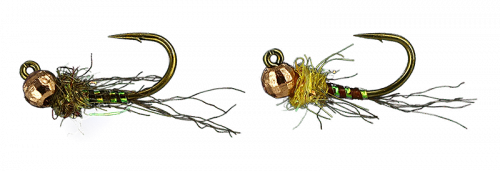
Perdigon nymphs are currently one of the hottest items in the nymph fisherman’s vernacular and fly box, and I am right there with them. These small, dense patterns are designed to sink very quickly, even in the fastest of flows. Features like tungsten beads and UV-cured bodies make them heavy, and a relative lack of any peripheral features (legs, heavy-dubbed thoraxes, etc.) that would impede the flies’ sink rate turn them into tiny anchors. They were initially popularized in competitive fishing circles, but are now widely known and available. Because I fish a number of rivers with swift flows and strong populations of small mayflies – and because I prefer not to use split shot unless absolutely necessary – Perdigon-style nymphs fill an important niche for me.
 Strictly speaking, the Jigster series of nymphs are not classic Perdigon-style nymphs. Though they do share some of the same features – heavy tungsten beads and UV-cured abdomens – they are also a bit different in that they have a soft tail (in place of the signature Coq de Leon of many Perdigons) and soft legs. I prefer these features in that they add a bit of material motion underwater, which I have found fish respond well to. There will be a very slight reduction in sink rate with these appendages, though for me they are worth the small sacrifice.
Strictly speaking, the Jigster series of nymphs are not classic Perdigon-style nymphs. Though they do share some of the same features – heavy tungsten beads and UV-cured abdomens – they are also a bit different in that they have a soft tail (in place of the signature Coq de Leon of many Perdigons) and soft legs. I prefer these features in that they add a bit of material motion underwater, which I have found fish respond well to. There will be a very slight reduction in sink rate with these appendages, though for me they are worth the small sacrifice.
I chose Z-Lon (Polytron Yarn, McFlylon Poly Yarn, or Antron Yarn) for the tails and legs of the Jigster Nymphs as it is available in a wide range of colors to match desired color schemes, has a nice sheen, and because it is fine in diameter, supple, and moves well underwater, responding to even the lightest of current buffeting. And unlike more traditional feather legs and tails, water flows through the sparse fibers readily, so barely affect the pattern’s sink rate. The abdomen is thread with a Flashabou rib, a style I have had great success with over many years, and I covered this portion of the fly with a UV glaze, Loon Flow, a step that increases weight and adds a bit of translucency. The thorax is a special dubbing blend – created with a number of different, blended colors – that aids in the illusion of life; virtually no aquatic insects that I observe have completely homogenous body coloration. And I use a tungsten bead, an innovation I have come to love as it allows me to fish nymphs without the need for split shot on the leader; adding shot, I feel, can negatively affect the drift of the nymph, and also create a disconnect to a “take” that makes strike detection more difficult.
 Last but not least, I have chosen to tie this nymph on a jig hook. I have found that, particularly in smaller sizes, I seem to hook and land more fish with this style of hook. Interestingly, I have experimented with fishing small jig nymphs under an indicator, purposefully not striking when a fish takes, and with just the tension of the indicator many fish struggle momentarily to spit the jig hook. As any successful nymph fisherman will attest, having an extra moment to react to a grab can make all the difference!
Last but not least, I have chosen to tie this nymph on a jig hook. I have found that, particularly in smaller sizes, I seem to hook and land more fish with this style of hook. Interestingly, I have experimented with fishing small jig nymphs under an indicator, purposefully not striking when a fish takes, and with just the tension of the indicator many fish struggle momentarily to spit the jig hook. As any successful nymph fisherman will attest, having an extra moment to react to a grab can make all the difference!
I have done very well with these little Jigster mayfly patterns, both beneath an indicator and fished with a tight-line presentation. Look for more nymphs from me in the future tied on jig hooks – I have become a big fan of them over the past couple of years!
 Mercer’s Jigster PMD – Recipe
Mercer’s Jigster PMD – Recipe
Hook: TMC 413J, #16 & #18
Bead: Slotted Tungsten – Gold; to match hook size
Thread: Ultra 140 Thread – Orange
Tail: Z-Lon (Polytron Yarn, McFlylon Poly Yarn, or Antron Yarn) – Brown; sparse
Abdomen: Ultra 140 Thread – Orange; ribbed with pearl Flashabou and coated with Loon UV Flow
Thorax: Dubbing – Bright Yellow; preferably with some flash to it. Ice Dub – UV Hot Yellow will work
Legs: Same as tail (Polytron Yarn, McFlylon Poly Yarn, or Antron Yarn)
 Mercer’s Jigster BWO – Recipe
Mercer’s Jigster BWO – Recipe
Hook: TMC 413J, #16 & #18
Bead: Slotted Tungsten – Gold; to match hook size
Thread: Ultra 70 Thread – Olive
Tail: Z-Lon (Polytron Yarn, McFlylon Poly Yarn, or Antron Yarn) – Brown; sparse
Abdomen: Ultra 70 Thread – Olive; ribbed with pearl Flashabou and coated with Loon UV Flow
Thorax: Arizona Diamond Dubbing – #29 Light Olive
Legs: Same as tail (Polytron Yarn, McFlylon Poly Yarn, or Antron Yarn)


